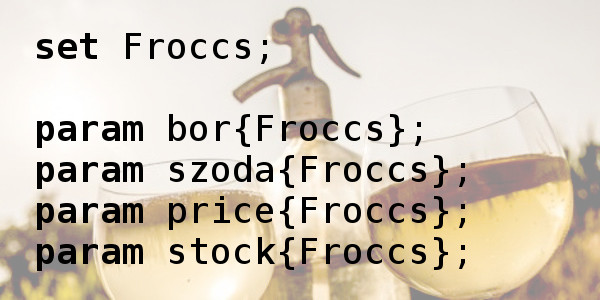
Advanced GMPL models for motivational examples
Advanced GMPL models of the motivational examples
- Prerequisites Advanced GMPL techniques: data/logic decoupling
We have already made the advanced model of for the Festivals example. In this practice session, try to do the same for the Fröccs example.
Advanced GMPL model for the fröccs example
First try to create a more general model, where the fröccs types are given as data. The very first step is to identify the necessary set and parameter definitions. Reveal set and parameter definitions
| Mathematical notation | GMPL code |
|---|---|
| Sets and parameters | |
| \(F\) | set FroccsTypes; |
| \(p_{f}\qquad f\in F\) | param price{FroccsTypes}; |
| \(s^{s}\) | param soda_stock; |
| \(s^{w}\) | param wine_stock; |
| \(c^{s}_{f}\qquad f\in F\) | param soda_content{FroccsTypes}; |
| \(c^{w}_{f}\qquad f\in F\) | param wine_content{FroccsTypes}; |
The second step is to create the variables, constraints and objective function of the generic model. Reveal the generic model
| Mathematical notation | GMPL code |
|---|---|
| Variables | |
| \(q_f\qquad f\in F\) | var quantity{FroccsTypes}>=0; |
| Constraints | |
| \(\displaystyle\sum_{f\in F} q_f \cdot c^s_f \le s^s\) | s.t. SodaUsage: sum{f in FroccsTypes} quantity[f] * soda_content[f] <= soda_stock; |
| \(\displaystyle\sum_{f\in F} q_f \cdot c^w_f \le s^w\) | s.t. WineUsage: sum{f in FroccsTypes} quantity[f] * wine_content[f] <= wine_stock; |
| Objective function | |
| \(\displaystyle\sum_{f\in F} q_f \cdot p_f \to max\) | maximize Income: sum{f in FroccsTypes} price[f] * quantity[f]; |
Last, but not least, provide data for the model in a data file Reveal data file
set FroccsTypes :=
kisfroccs
nagyfroccs
hosszulepes
hazmester
vicehazmester
krudyfroccs
soherfroccs
puskasfroccs
;
param price :=
kisfroccs 110
nagyfroccs 200
hosszulepes 120
hazmester 260
vicehazmester 200
krudyfroccs 800
soherfroccs 200
puskasfroccs 550
;
param soda_stock := 1500;
param wine_stock := 1000;
param soda_content :=
kisfroccs 1
nagyfroccs 1
hosszulepes 2
hazmester 2
vicehazmester 3
krudyfroccs 1
soherfroccs 9
puskasfroccs 3
;
param wine_content :=
kisfroccs 1
nagyfroccs 2
hosszulepes 1
hazmester 3
vicehazmester 2
krudyfroccs 9
soherfroccs 1
puskasfroccs 6
;
More general Product-mix model
We feel, that this model is still very specific to beverages made from soda and wine. If we were to have a problem instance with different products, that use given portions of certain raw materials, and given were all the price and stock data as well, the model would be very similar. So now, try to create a model, where it is not hardcoded to have two types of ingredients, but it would be given by a set. Reveal model file with data section
set Products;
set Ingredients;
param price{Products};
param stock{Ingredients};
param content{Products,Ingredients};
var quantity{Products}>=0;
s.t. IngredientUsage{i in Ingredients}:
sum{p in Products} quantity[p] * content[p,i] <= stock[i];
maximize Income:
sum{p in Products} price[p] * quantity[p];
data;
set Products :=
kisfroccs
nagyfroccs
hosszulepes
hazmester
vicehazmester
krudyfroccs
soherfroccs
puskasfroccs
;
set Ingredients :=
soda
wine
;
param price :=
kisfroccs 110
nagyfroccs 200
hosszulepes 120
hazmester 260
vicehazmester 200
krudyfroccs 800
soherfroccs 200
puskasfroccs 550
;
param stock :=
soda 1500
wine 1000
;
param content :
soda wine :=
kisfroccs 1 1
nagyfroccs 1 2
hosszulepes 2 1
hazmester 2 3
vicehazmester 3 2
krudyfroccs 1 9
soherfroccs 9 1
puskasfroccs 3 6
;
end;
More general Product-mix model
To test Your skills, try to make the generic model for a more sophisticated festival example. First, to warm-up, include the price of each festival, and make the objective to minimize the total cost instead of the number of festivals.
Secondly, define the dates of the festivals, and introduce a new constraint, that You can not be at two places at the same time.
Finally, try to extend the model with something on Your own, to make it more realistic.